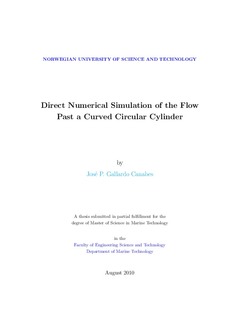Direct Numerical Simulation of the Flow Past a Curved Circular Cylinder
Master thesis
Permanent lenke
http://hdl.handle.net/11250/237728Utgivelsesdato
2010Metadata
Vis full innførselSamlinger
- Institutt for marin teknikk [3471]
Sammendrag
Offshore marine applications often include configurations of cylindrical structures that produce complex three-dimensional flow features. Catenary risers, for instance, can create complex flow patterns when subjected to hydrodynamic loads. In recent published studies, the shape of a catenary riser has been approximated by a quarter segment of a ring followed by a horizontal extension, obtaining a curved circular cylinder. In the present Master thesis, Direct Numerical Simulations at Re = 100 and 500 have been conducted in order to study the flow past such geometry. The main flow direction was parallel to the plane of curvature of the cylinder and directed towards the convex face of the quarter-of-ring. Additionally, a sheared incoming flow has been considered in the analysis by imposing a linearly varying velocity profile at the inlet.
The shedding mechanism observed in uniform flow was similar to that reported in previous published studies. One single shedding frequency prevailed along the entire span of the cylinder at Re = 100 and 500. Moreover, the vortex cores at Re = 100 were normal to the flow direction and exhibited slight distortions as they were convected downstream, whereas at Re = 500 the wake topology was characterized by three-dimensional structures of smaller scale. A sheared inflow, on the other hand, gave rise to an oblique and cellular vortex shedding pattern with two cells of different shedding frequencies. The strong slanting of the vortices, as well as the cellular pattern, was clearly induced by the variation of the local Reynolds number along the front stagnation point.
The basic knowledge gained from this thesis appear as very promising in the context of marine structures, it is therefore expected that this work will constitute a basis for further investigations considering this type of geometry.
